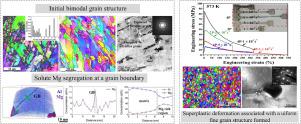International Journal of Plasticity ( IF 9.8 ) Pub Date : 2021-09-05 , DOI: 10.1016/j.ijplas.2021.103108 Min Zha 1, 2 , Hongmin Zhang 1 , Hailong Jia 1, 2 , Yipeng Gao 1, 2 , Shenbao Jin 3 , Gang Sha 3 , Ruben Bjørge 4 , Ragnvald H. Mathiesen 5 , Hans J. Roven 6 , Huiyuan Wang 1, 2 , Yanjun Li 6

|
Achieving high superplasticity in single-phase Al alloys remains a challenge, since the fine-grained structure required for superplastic deformation coarsens rapidly in the absence of dispersed second-phase particles during tensile deformation at elevated temperatures. This paper concentrates on the superplastic response of a high solid solution Al–7Mg alloy processed by equal-channel angular pressing (ECAP) under uniaxial tension. The ECAP-processed Al–7Mg alloy features multi-scale microstructural heterogeneities including a bimodal grain structure and Mg solute segregation along grain boundaries (GBs) of nano/ultrafine grains. To identify effects of multi-scale microstructural heterogeneities on superplastic deformation behavior of the high solid solution Al–7Mg alloy, microstructural evolutions are studied systematically by combing electron backscatter diffraction (EBSD), ASTAR-transmission electron microscopy (TEM) orientation imaging and atom probe tomography (APT). During deformation at the optimal tensile condition of 573 K and 1 × 10−3 s−1, the heterogeneous microstructure evolves to a stable uniform fine grain structure via continuous dynamic recrystallization (CDRX), and impressive superplasticity of ∼523% elongation is achieved. The high superplasticity is discussed in terms of the cooperated mechanism by dislocation slip accommodated by CDRX at the early tensile deformation stage and grain boundary sliding (GBS) at the late deformation stage. Our findings show that the evolution of microstructural heterogeneities in high solid solution Al–Mg alloys can be regulated, favoring for superplastic deformation, which offers an alternative strategy for developing low-cost Al alloys for enhanced mechanical properties.
中文翻译:

多尺度显微组织异质性对高固溶Al-7Mg合金超塑性变形的突出作用
在单相铝合金中实现高超塑性仍然是一个挑战,因为在高温拉伸变形过程中,在没有分散的第二相颗粒的情况下,超塑性变形所需的细晶粒结构会迅速变粗。本文重点研究了在单轴拉伸下通过等通道角挤压 (ECAP) 加工的高固溶体 Al-7Mg 合金的超塑性响应。ECAP 处理的 Al-7Mg 合金具有多尺度微观结构异质性,包括双峰晶粒结构和沿纳米/超细晶粒的晶界 (GBs) 的 Mg 溶质偏析。为了确定多尺度显微组织异质性对高固溶 Al-7Mg 合金超塑性变形行为的影响,通过结合电子背散射衍射 (EBSD)、ASTAR 透射电子显微镜 (TEM) 定向成像和原子探针断层扫描 (APT),系统地研究了微观结构演变。在 573 K 和 1 × 10 的最佳拉伸条件下变形期间-3 s -1,非均质微观结构通过连续动态再结晶(CDRX)演变为稳定均匀的细晶粒结构,并实现了令人印象深刻的~523%伸长率的超塑性。高超塑性从拉伸变形早期CDRX 容纳的位错滑移和变形后期晶界滑动(GBS) 的协同机制进行了讨论。我们的研究结果表明,可以调节高固溶体 Al-Mg 合金中微观结构异质性的演变,有利于超塑性变形,这为开发低成本铝合金以提高机械性能提供了一种替代策略。



























 京公网安备 11010802027423号
京公网安备 11010802027423号